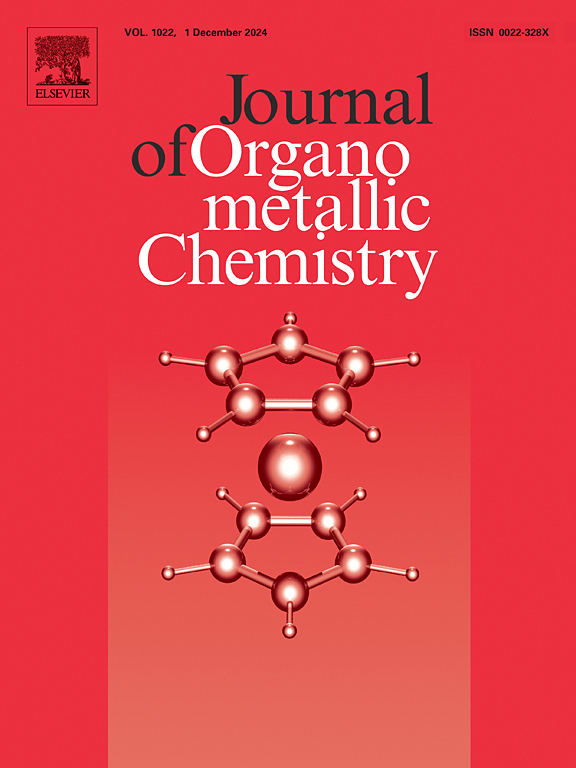单聚和二聚钯环配合物的探索:[Pd(PPh3)(bhquin)(sac)]的光谱、生物学、分子对接和x射线晶体结构
IF 2.1
3区 化学
Q3 CHEMISTRY, INORGANIC & NUCLEAR
引用次数: 0
摘要
双核糖化配合物[Pd(µ-sac)bhquin]2 (sac =三苯基膦)与双核[Pd2(sac)2(µ-p^p)(bhquin)2] (3-7)(p^p = Ph2PCH2PPh2 (dppm)、Ph2P(CH2)2PPh2 (dppe)、Ph2P(CH2)3PPh2 (dppp)、Ph2P(CH2)4PPh2 (dppb)、(Ph2P (CH2)4PPh2 (dppb)、(Ph2PC5H4)2Fe (dppf)) [Pd(µ-sac)bhquin]2 (sac =糖化),Bhquin(去质子化苯醌酸酯)分别与一摩尔二膦或两摩尔单膦配体反应。值得注意的是,在配合物3、4和5中,bhquin分子的一个氮原子反式到二膦的磷原子上,bhquin的另一个碳分子反式到二膦的磷原子上。另一方面,在配合物6和7中,二膦的氮原子被转到二膦的磷原子上。通过电导、元素分析、不同的光谱方法(IR、1H-、31P-NMR)和x射线晶体学对新配合物进行了表征。利用密度泛函理论(DFT)计算了键长和键角之间的比较。分子对接研究也测定了所制备化合物的抗菌潜力。本文章由计算机程序翻译,如有差异,请以英文原文为准。
![Exploration of monomeric and dimeric palladacyles complexes: Spectroscopic, biological, molecular docking and X-ray crystal structures of [Pd(PPh3)(bhquin)(sac)]](https://img.booksci.cn/booksciimg/2025-7/102305802211784152822.jpg)
Exploration of monomeric and dimeric palladacyles complexes: Spectroscopic, biological, molecular docking and X-ray crystal structures of [Pd(PPh3)(bhquin)(sac)]
Novel cyclometalated palladium(ІІ) complexes type mono nuclear [Pd(PPh3)(bhquin)(sac)](2) (PPh3= triphenylphosphine) and binuclear [Pd2(sac)2(µ-p^p)(bhquin)2] (3–7) (p^p = Ph2PCH2PPh2 (dppm), Ph2P(CH2)2PPh2 (dppe), Ph2P(CH2)3PPh2 (dppp), Ph2P(CH2)4PPh2 (dppb), (Ph2PC5H4)2Fe (dppf) were obtained from the reaction of the binuclear saccharinato complex [Pd(µ-sac)bhquin]2 (1) (sac = saccharinate, bhquin= deprotonated benzoquinolate ) reacts with one-mole diphosphine or two mole of mono phosphine ligands, respectively. It is worth noting that in complexes 3, 4, and 5, a nitrogen atom of one molecule bhquinuin is trans to the phosphorus atom of the diphosphine, and the other molecule carbon of bhquin is trans to the phosphorus atom of the diphosphine. On the other hand, in complexes 6 and 7, the nitrogen atom of bhquin is trans to the phosphorus atom of the diphosphine. The new complexes were characterized by electric conductance, elemental analysis, and different spectroscopic methods (IR, 1H-, 31P-NMR) as well as X-ray crystallography. A comparison between the bond lengths and angles was calculated using Density Functional Theory (DFT). Molecular docking studies were also performed to assay the antibacterial potential of the prepared compounds.
求助全文
通过发布文献求助,成功后即可免费获取论文全文。
去求助
来源期刊

Journal of Organometallic Chemistry
化学-无机化学与核化学
CiteScore
4.40
自引率
8.70%
发文量
221
审稿时长
36 days
期刊介绍:
The Journal of Organometallic Chemistry targets original papers dealing with theoretical aspects, structural chemistry, synthesis, physical and chemical properties (including reaction mechanisms), and practical applications of organometallic compounds.
Organometallic compounds are defined as compounds that contain metal - carbon bonds. The term metal includes all alkali and alkaline earth metals, all transition metals and the lanthanides and actinides in the Periodic Table. Metalloids including the elements in Group 13 and the heavier members of the Groups 14 - 16 are also included. The term chemistry includes syntheses, characterizations and reaction chemistry of all such compounds. Research reports based on use of organometallic complexes in bioorganometallic chemistry, medicine, material sciences, homogeneous catalysis and energy conversion are also welcome.
The scope of the journal has been enlarged to encompass important research on organometallic complexes in bioorganometallic chemistry and material sciences, and of heavier main group elements in organometallic chemistry. The journal also publishes review articles, short communications and notes.
 求助内容:
求助内容: 应助结果提醒方式:
应助结果提醒方式:


